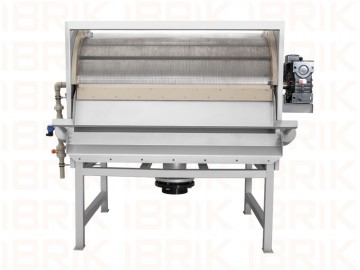DRUM SCREEN
They are the thinnest gratings installed in the pipeline. It has the feature of holding solids with a particle size of 0.25-0.5 mm. It is most commonly used in wastewater treatment plants of industries. The drum sieve works on the principle of keeping the solid wastes present in the incoming water out of the sieve.
Drum sieves are generally;
Drum
Scraper blade
Counterweight
Body
Sub Chassis
Output Chamber
It consists of Drive Unit.
The main body is made of carbon steel coated with epoxy paint. The outlet chamber is produced from polypropylene material. Specially triangular and very finely cut wires are made into drums with special processes. Its fine porosity allows solid wastes to be kept to a large extent, minimizing the pollution level of the wastewater and allowing it to operate with high efficiency in terms of water circulation.
The solid waste remaining on the drum is cleaned with the help of scraper and conveyed to the disposal point. The system starts to work by giving the waste water taken to the feeding tank to the drum sieve.
The suspended wastes on the drum are scraped off by the continuous rotation movement of the drum. The filtered water is discharged from the outlet point. There is a washing system inside the drum sieve. This system works by spraying pressurized water so that the oily particles in the waste do not clog the grid pores.
The drum consists of spirals formed by parallel and triangular cut wires. The counterweight is adjusted by moving the weight back and forth between the sieve surface and the blade and the pressure exerted by the blade on the drum.
The outlet chamber is used to transfer the wastes scraped from the drum to the container. It is produced from PP material. The drive unit consists of protected motors as standard and a gear group that will catch the most suitable speed for the drum by considering the output speed of the motor.

